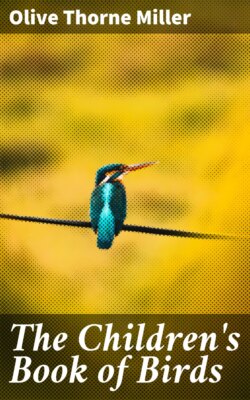Читать книгу The Children's Book of Birds - Olive Thorne Miller - Страница 13
На сайте Литреса книга снята с продажи.
VI
ОглавлениеTable of Contents
HIS FIRST SUIT
Some birds that live on the ground—as I told you—have dresses of down to begin with. These little fellows have no warm nest to stay in, but run around almost as soon as they come out of the egg. Young ducks and geese wear this baby suit for weeks, before they begin to put on their feather coats.
Young birds that spend most of their time in the water, like grebes, and others that live in a cold country, have the down very thick and fine, like heavy underclothes, to keep them dry and warm.
Birds whose home is underground, like the kingfisher, or in the trunk of a tree, like the woodpecker, have hardly any down at all. They need no baby clothes in their warm cradles.
Robins and most other song birds have only a little down on them, and very soon the feathers begin to grow.
When the tiny quills push themselves up, they look like little white pins sticking out all over. Each bit of down grows out of a little raised place on the skin that looks like a pimple, and the feather comes out of the same.
YOUNG WOOD THRUSH
As the feather grows, the bit of down clings to it till it is broken off. Sometimes it holds on till the feather is well out. We can often see down sticking to a young bird's feathers.
The little feathers grow very fast, and before he is ready to fly a young bird is well covered. Birds hatched with their eyes open, and already dressed, who have to run and fly very soon, get their wing feathers early; but birds who live many days in the nest, like robins and bluebirds, do not get theirs till they are nearly grown.
The tail feathers are the last to come to full length, and you will notice that most birds just out of the nest have very dumpy tails.
A bird's first suit of feathers is called his nestling plumage. In some families it is just like the dress of the grown-up birds, but in others it is not at all like that. It is usually worn only a few weeks, for the young one outgrows it, and needs a new and bigger one before winter.
When a bird is fully dressed, his body is entirely covered, and it looks as if the feathers grew close to each other all over him. But it is not so. The feathers grow in patterns, called "feather tracts," with spaces of bare skin between them. These bare places do not show, because the feathers lap over each other and cover them.
The pattern of the feather tracts is not the same in all birds. A few birds of the Ostrich family have feathers all over the body.
There is another curious thing about the nestling plumage. You would expect a young bird to look like his father or mother; and some of them do. Many nestlings are dressed exactly like their mothers; and not until they are a year old do the young males get a coat like their father's. Some of them, indeed, do not have their grown-up suits for two or three years.
Then, again, many young birds have dresses different from both parents. Young robins have speckled breasts, and spots on the shoulders, which the old birds have not.
When the father and mother are dressed alike, as the song sparrows are, the young birds generally differ from both of them. When the father and mother are different, like orioles or bluebirds, the young are usually like the mother the first season. In some cases the father, mother, and young are almost exactly alike.
Birds who live on the ground need dresses of dull colors, or they would not be very safe. The ostrich mother, who makes her nest in plain sight on the sand, is dressed in grayish brown. When she sits on the eggs, she lays her long neck flat on the ground before her; then she looks like one of the ant-hills that are common on the plains of Africa, where she lives.
The South American ostrich, or rhea, fluffs out her feathers and looks like a heap of dry grass. The male ostrich is dressed in showy black and white, and he stays away all day, but takes care of the nest at night, when his striking colors cannot be seen.
